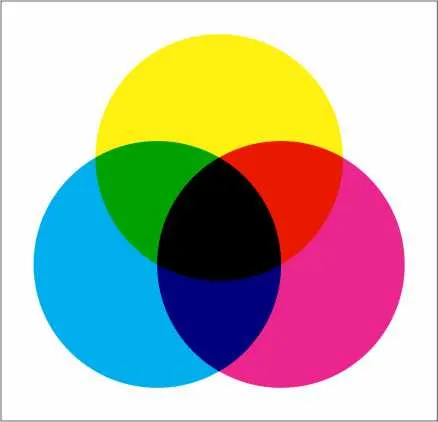
Addition and Subtraction
Many of us were taught as children that the primary colors are Red, Yellow, and Blue. It is often simplified in this way for children. I myself suffered from this incorrect color model for many years! Many students never learn anything different, often never having needed to take a class which covered the correct models.
There are two basic color models: additive and subtractive. Subtractive is used in pigments, and the primaries are Magenta, Yellow, and Cyan--the secondaries thereof are as follows:

- Yellow and Magenta = Red
- Magenta and Cyan = Blue
- Cyan and Yellow = Green
The reason this is, is because your eyes actually see only three colors of light:

Think of pigments as light-absorbents: a Cyan pigment absorbs Red, and so Cyan consists of Blue and Green being reflected-which your mind understands as Cyan. When you mix Cyan(absorbs Red) with Magenta(absorbs Green), you end up with only Blue being reflected.
This is why printers use CMYK, a subtractive color model. In CMYK, there is a Black pigment added to enhance shading, as it is next to impossible to match CMY perfectly into black. It is this same inequality between pigments that causes there to often be a discernible difference between an image seen on a screen, and the same image having been printed. The map of available colors based on any given set of pigments or light sources is called a "Color Space".
Inversely, when discussing light, you are discussing additive color, wherein you could take a Red light, and a Blue light, and when you shine them both at the same piece of White paper, you see Magenta.
In theatrical or concert lighting, we often use RGBW LED fixtures that have a Red, Green, Blue, and White LED. The white LED serves the same purpose in lighting as the Black(or key) pigment serves in printing: it is incredibly difficult and tedious to balance the R, G, and B lights to create a perfect White, and it also allows for more possibilities in highlighting people and objects on the stage.

P.S.While we're at it, check out @ksolymosi's excellent series on the Psychology of Color: https://steemit.com/psychology/@ksolymosi/the-psychology-of-colours-part-1-introduction

The Sauces:
- https://en.wikipedia.org/wiki/CMYK_color_model
- https://en.wikipedia.org/wiki/RGB_color_model
- https://en.wikipedia.org/wiki/Color_printing
- https://en.wikipedia.org/wiki/Color_space